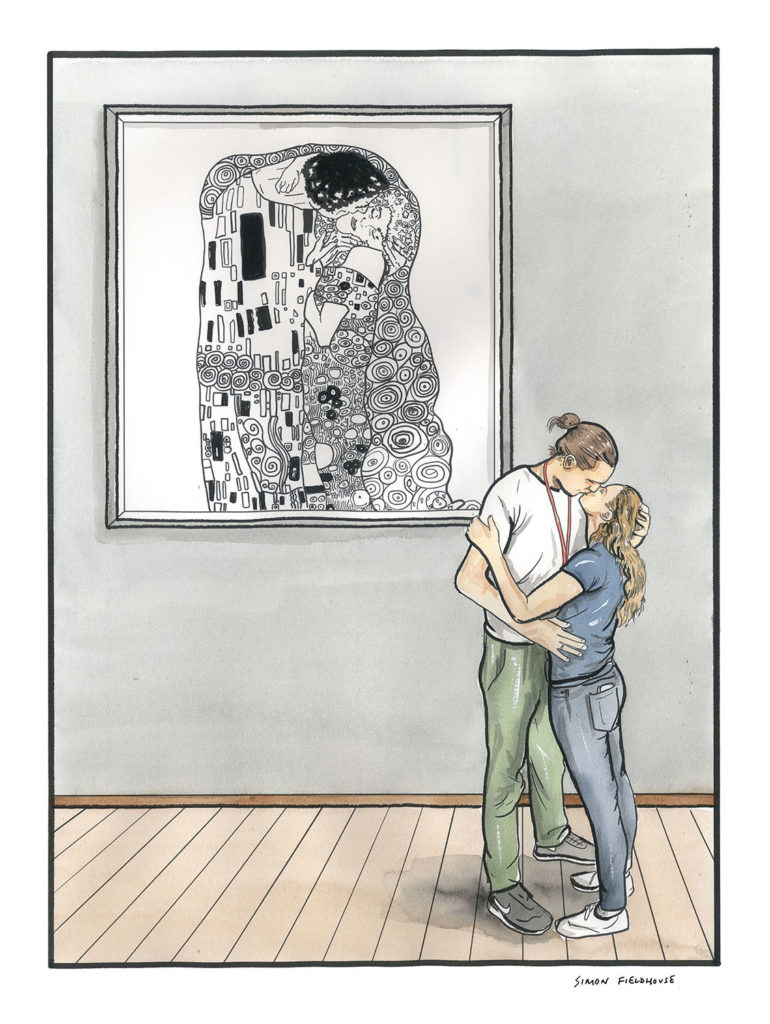
The Kiss - Gustav Klimt
Gustav Klimt's "The Kiss" stands as an enduring icon of both the Art Nouveau movement and the broader realm of art history. Painted between 1907 and 1908, this masterpiece encapsulates the essence of love, intimacy, and human connection in a mesmerizing display of color, pattern, and symbolism. With its intricate composition and rich symbolism, "The Kiss" invites viewers into a realm of profound emotion and sensuality.
At first glance, the painting depicts a couple locked in an intimate embrace, their bodies intertwined amidst a field of vibrant golden patterns. The male figure tenderly leans towards his partner, enveloping her in a passionate kiss. Their bodies merge seamlessly, forming a harmonious union that transcends earthly boundaries. The woman, enveloped in a flowing robe adorned with intricate patterns, gazes upward with closed eyes, surrendering herself completely to the moment of ecstasy.
Klimt's use of gold leaf in "The Kiss" is particularly striking, imbuing the painting with a sense of opulence and transcendence. The shimmering gold serves as a metaphor for the divine nature of love, elevating the ordinary moment into something sacred and eternal. It also reflects Klimt's fascination with Byzantine art and its emphasis on decorative motifs and symbolism.
Beyond its surface beauty, "The Kiss" is laden with symbolism that adds layers of depth to its interpretation. The embrace of the couple represents not only physical intimacy but also emotional connection and spiritual union. The woman's closed eyes suggest a state of blissful surrender, while the man's protective gesture conveys a sense of devotion and reverence.
The swirling patterns that envelop the couple further enhance the painting's symbolic richness. These intricate motifs, reminiscent of both natural forms and geometric designs, evoke the complexities of human relationships and the interconnectedness of all living things. They also serve as a visual representation of the cyclical nature of life and love, with their rhythmic repetition suggesting an eternal cycle of birth, death, and renewal.
"The Kiss" also reflects the cultural and social context of its time. Painted during the height of the Belle Époque era in Vienna, the painting captures the spirit of hedonism and artistic experimentation that characterized the period. Klimt's bold exploration of sensuality and eroticism challenged the conservative norms of society, paving the way for a more liberated and expressive approach to art.
Moreover, "The Kiss" can be seen as a celebration of the feminine and a rejection of traditional gender roles. The woman in the painting is not merely an object of desire but an active participant in the embrace, asserting her agency and autonomy. This subversion of gender norms was radical for its time and continues to resonate with contemporary audiences.
In conclusion, Gustav Klimt's "The Kiss" is a timeless masterpiece that continues to captivate and inspire viewers over a century after its creation. Through its exquisite beauty, rich symbolism, and profound emotional resonance, the painting transcends its historical context to speak to the universal themes of love, intimacy, and human connection. It invites us to ponder the mysteries of the heart and to contemplate the transformative power of love in all its forms.